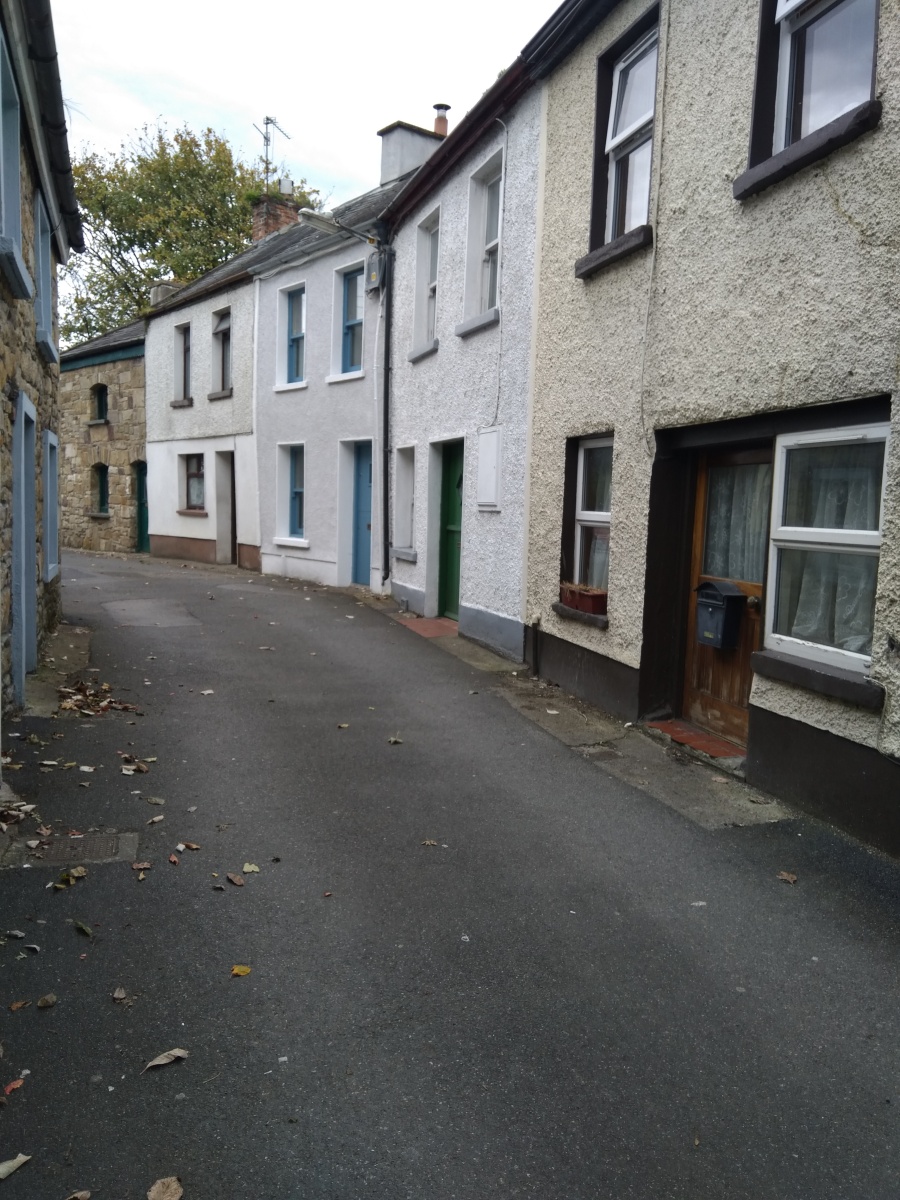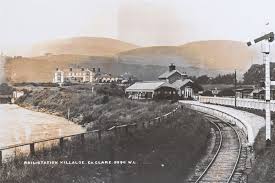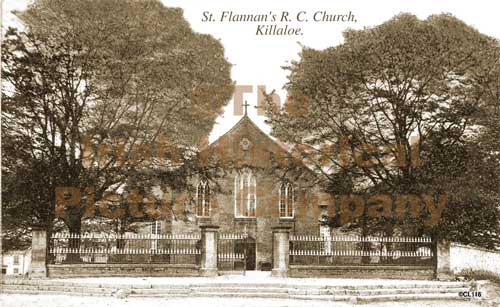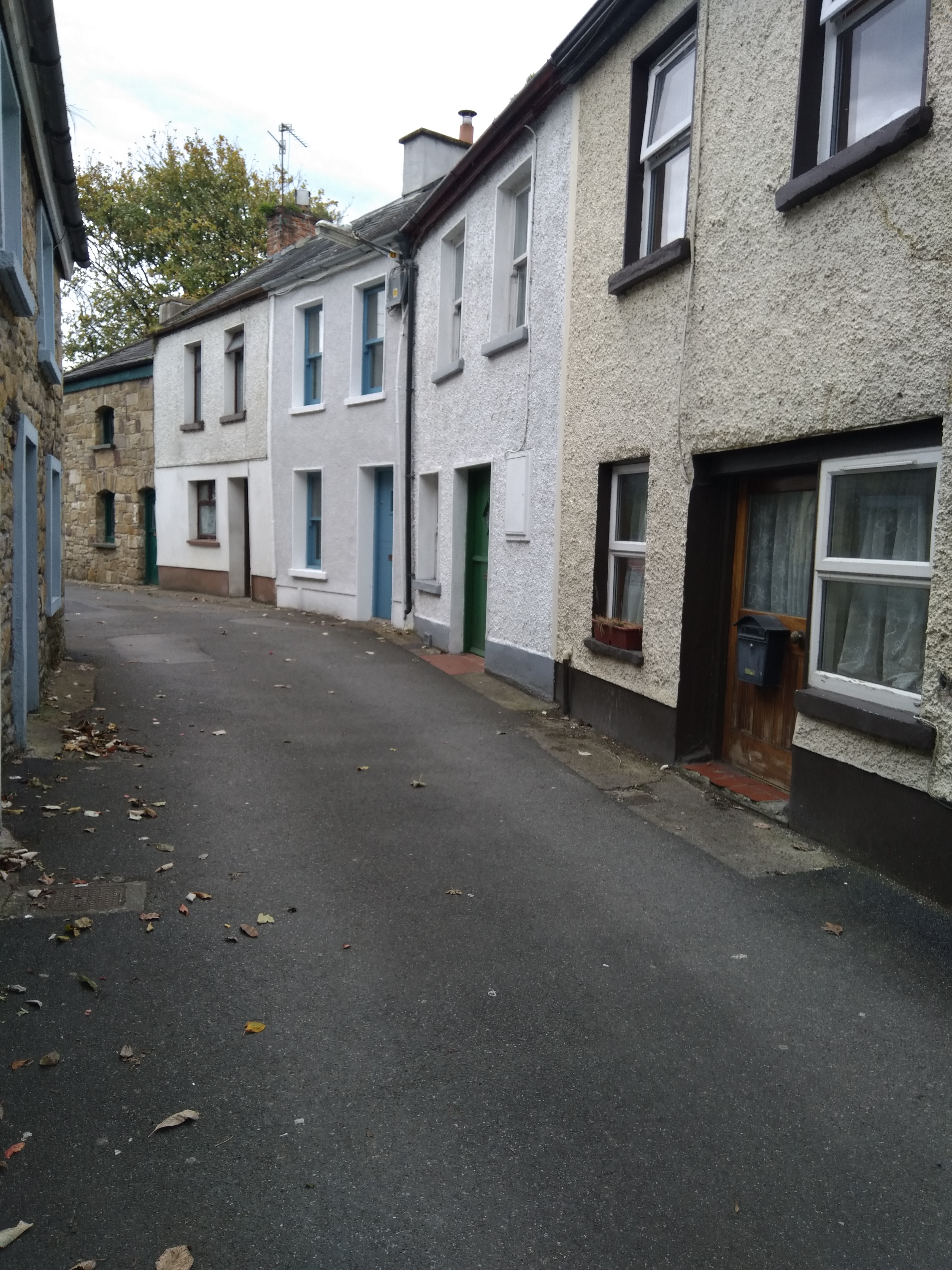Moira Ryan lived on Abbey Street in Killaloe, (now known as Convent Hill) in the building beside by An Siopa Beag. She lived here until her death in 2006.
You can listen to the full interview here through Soundcloud!

Moira: My grandmother came from The Glen, she was Mary O’Neill and she married George Shouldice. He came down from Banagher side, and they came to live in Killaloe and they both died here.
What did he do for a living?
Moira: He was working on the Canal boats, my grandfather. My father was working, a labouring man.
What was your grandfather doing on the Canal boats?
Moira: He was driving the Shannon with Joe Reddan, Canal Bank, that was years ago now, and a McEvoy man. The McEvoy man still has relations – all those people lived down the Canal Bank, – she is married to Quigley, Monnie Quigley’s son, they all worked on the boats on the Shannon. He was driving it and the others were skippers.
So where did he go? What would his trips have been?
Moira: His trips would be up to Banagher and up along the river, where ever, you see you wouldn’t bother about things in those days, all you were interested in was what he would bring when he’d come back.
Were they the old barges?
Moira: Those were the old barges, yes.
What goods would they have carried on board?
Moira: I haven’t a clue.
How long would he be away?
Moira: He’d often be away for two or three days, and in stormy weather, in winter, they would tie up at another lock. Now Michael Connolly would give you news about that, his father was involved on the barges.
Can you remember any old stories he told you?
Moira: No, he was not that kind of man at all, he was a very quiet, solid man, The stories he would tell was, he didn’t like ghost stories, because he used to say they were pure rot, rubbish, so he was inclined to believe the one night in his life, he was delayed out and it was a moonlit night, and they pulled in at midnight at the Pier Head, and he felt that there was chains behind him, rattling, so the sweat come out through him and t’was the first time in his life he was beginning, the Pier Head had the name of always being haunted, you would see things and hear things, but he went to the Pier Head at every hour and he never saw nothing and he counted it all rubbish, which it was.
The chains rattled, so he’d stand awhile, he was trying to go quick, and when he would stand, the chains would stop, so he came up the Aillebhaun, out Hogan’s Lane, we know it, Alec Hogan’s, where they are doing the houses, that was known as Hogan’s Lane, so he turned Hogan’s Lane and the chains came too, so he was tired from going quick and frightened with all the yarns you would hear, so when he came out on New Street, the chains completely stopped, so he got a bit of courage and when he was up a bit, he looked back and what were the chains? But two goats tied together. Wasn’t that worth hearing?
So he hadn’t been imagining it?
Moira: No he hadn’t imagined it but it was the only thing that knocked him. And of course from that on you couldn’t get him to believe anything in that line.
How many years would he have been on the barges?
Moira: I suppose he was in it since he was a young lad.
Did he enjoy it?
Moira: He did, it was all that was making money in them days, there was no money.
What company did he work for – The Shannon Navigation Company?
Moira: I think so under Dudley Fletcher, he used to live in Castleconnell and then he had a house-boat when he came here.
And did he have a lot of boats?
Moira: T’was belonging to the Shannon and he was over it.
He was just like a foreman, was he?
Moira: Dudley Fletcher was, yes.
So in those days he lived up in the Glen.
Moira: No they didn’t, they were down out of the Glen once my mother married, and her father died, and when her mother got ill, and bad, she brought her down.
The Glen at that time was hard to get into.
Can you remember it?
Moira: No I don’t but Doctor Courtney and ourselves, we got a call to Crowe’s and Mrs, Murphy was a niece of Crowe’s, and she left her house to a Tony Byrne’s inO’Briensbridge, and we were up and we asked the old Crowe’s “where did Mary O’Neill live, my grandmother, they were very old so he pointed the spot. It was not very far from where Tony Byrnes is now, but ’twas only a ruin, you could not make it out, but you would know that there was a house there, donkey’s years ago.
You never married did you?
Moira: No.

So what did you do in your young days? Where were you actually born?
Moira: I was born in John Street, here in the lane, I have not moved very far, I only moved down. There was a nice lot of people there in them days, it wasn’t rough nor ready, t’was lovely.
Can you describe what John’s Lane was like?
Moira: It was beautiful then, small houses down along, all white-washed, all done up for Christmas, with decorations, holly, a really heavenly place.
No school then of course?
Moira: No. My grandmother lived where the National School is now, and opposite then was an Undertaker, Michael Larkin, he is dead now, that house was there, that would be Jimmy Whelan’s garden now, he bought all of that, Larkin was the undertaker there for years. I went to Doctor Courtney’s then, here where Jimmy Whelan is, and I gave twenty two years there, and I went from that to the Weaving Factory, and I gave fourteen years there, that was thirty six years out working, so I was glad to finish, wouldn’t you?
Where was the Weaving Factory then?
Moira: Do you know where the Eye Factory is now, there.
What hours did you work there?
Moira: Half eight to half five. I liked it immensely.
It was a shame that it closed down.
Why do you think it closed?
Moira: I suppose things got dearer, and wool got dearer, you know. The youngsters don’t buy what older people buy, they would rather a cheaper thing, because they don’t have it (the money), and those wool things were kind of old-fashioned, they are in youngsters’ eyes, aren’t they?
Moira: Ryan’s Dance Hall was our outing, when I could get off, it was on from nine o’clock to twelve o’clock, the practice, a shilling for the dance, lovely dance, and there would be a dance on an odd Sunday night, from nine o’clock to three o’clock, that would be for Ogonnolloe farmers, and Mrs. Ryan would have a few herself, it was lovely. And there was the Picture Hall, it was lovely, four pence.
Can you ever remember any of the pictures you saw?
Moira: No because I wasn’t a picture goer, t’was the dances, t’wasthe Dance Hall was our craze.
Can you remember the Temperance Band?
Moira: I can. They were lovely.
What were you interested in then growing up as a girl. What were your hobbies?
Moira: I loved sewing and knitting. I was never any good to cycle, I started it but after a couple of falls, it finished the job. I loved reading and I was never a good traveller, so that ruined me with that.
Would you sew and knit for your family or for other people?
Moira: For myself and the family. At the moment, I am knitting, I’m used to the same old pattern.
Do you remember the McKeogh ladies up along here who had a dressmakers?
Moira: They were our best friends. There was nine of them in family, eight girls and one boy, very respectable people, and they had a farm out in Birdhill, so they had a good few hundred fortune to get each, which was alot in those days, so Mary was great with a Phillip Ryan from Gurtshane, Newport, she was the only one of them that married, so what ever happened about the match, I don’t know whether the Ryan’s didn’t want it or whether the McKeogh’s didn’t want it, but it fell through, and she was great with him for a long time so Phillip Ryan went to America and got married and they had a boy and a girl, and the boy and girl had poor health and the wife died, so he came back and he had made quite a bit of money in America and so he married Mary in later life. Two of the dressmakers, when they got their money, they were trained in Nenagh, Katie and Bridgie, Ellen and I can’t think of the other girls name, they went to Nenagh and opened a shop, but they didn’t so well, they went down in it and closed and spent their money then, so Mary in Gurtshane, took Lizzie and Katie and Bridgie took Ellen, they were getting on in years then, so Ellen helped to tack in the work-room and cooked for them and they were a very happy, respectable family.
So where exactly was the business in Killaloe?
Moira: Next to James Minogue’s.
Did they ever employ anyone?
Moira: No, they did it themselves.
How many years were they there?
Moira: They must have been there forty years, they had a good business and Katie lived to be ninety-two, every one of them are dead now, we went in to them, up to the night they died. The last one, John Joe McKeogh, was a very nice man, and he took her home to live with him, Lizzie was the last, she was very happy with them, and he having a big family, he would be a first cousin of Sister Noreen O’Rourke.
Can you remember any other industry that was going in Killaloe/Ballina at the time? Do you remember the hotels?
Moira: There wasn’t any industries. Hurley’s had a hotel, where Kearney’s are now, I don’t know only to hear of it, and they had a hotel, they called it “The Royal”, Kearney’s and Walshe’s were one house, I don’t know why that closed, I suppose times went down.
Originally that was known as the Ponsenby Hotel?
Moira: I never heard of that. It is only from my mother now that I heard of that, they had two houses in Abbey Street and they came when the hotel closed, people who used to come for dapping knew them from going to the hotel, and in the second house, they used to keep fishermen, alot would come from England in olden days. There was Grace’s hotel, where Sean Ryan is, well all the English gentry came there, there was Kathleen Grace and Minnie Grace, and they made quite a living there, and the Shannon View of course was there, there at the corner, where the seat is, that’s knocked now, that did well.
Did you ever go into the hotels?
Moira: No.
Did people not go into those days– were they just for residents?
Moira: I suppose they were more for visitors. In those days, we would not dream of going into a pub, we were pioneers, myself, we have the Golden Jubilee done, we were never in pubs as you can see by that, there was no such thing in my young days, as women going to pubs, t’would be very wrong, that’s all gone.
Can you remember the Shannon Scheme?
Moira: I can. It was very good, The Shannon Scheme paid well and gave alot of work and there was alot around here used to cycle to it, my father cycled to it, down to Clonlara and O’Briensbridge, there was no way of going, only cycling. There was day shifts and night shifts and for the Shannon Scheme, the water rose and there was a McGee’s lock, down about a mile, and that was underground from the Shannon Scheme, about a mile down, past the Canal store.
Can you remember all the other barges coming in?
Moira: No. Those days, you wouldn’t be let out to any of those; no. no, you would go to school and do your lessons.
Where did you go to school?
Moira: Here in the Convent, the one that’s newly renovated.
When was that built?
Moira: A hundred years ago there last year.
So when was this present one built, here in the lane?
Moira: I don’t know, it’s up on the door, it’s not very long built.
What happened the houses were there, were they knocked down?
Moira: Demolished, they were very old. Jackie Corbett’s is still there, some of the houses were smaller than that.
How could people rear families in them?
Moira: They didn’t, t’was people with a few in family.
Were you ever involved with any fishing families at all?
Moira: Paddy Barry, his daughter was a first cousin of ours, her mother was Susan Shouldice, he fished all his life, a poor living, a very poor living, out all day in all weathers. It wasn’t a very good living. They lived out in Cloonfadda.
How much would he get for that for a day?
Moira: I haven’t an idea, but it wasn’t much anyway.
And that would have been just in the Summer season.
Moira: That’s all, up until October.
And what would he have done in the winter?
Moira: He did odd jobs, and in the spring before it would start, he’d dig gardens and that, there was not much work in those days.

Do you remember the trains?
Moira: I do, very much. They used to come in the afternoon, half three or four, Mother would take us children over to see the crowd coming, At nine o’clock, then sometimes, the people would go back and see them all going, that was all there was to it. They came from Limerick mostly and then there would be a Regatta day, and there would be a couple of trains, that would be a big day here.
Who were your teachers?
Moira: Sister Albert, Sister Oliver O’Reilly, she would be related to a Sister Eileen that was here, she’s gone out for a couple of years. Sister Columbanus, they’re all dead. There were eight or nine nuns in Killaloe at that time, t’washard going.
How many would have been in the school?
Moira: There was no secondary school here then.
And how many pupils would there have been?
Moira: Oh I don’t know but there would have been a fine lot.
Would they come from everywhere?
Moira: No, people hadn’t a way to travel then, they would come from Ogonelloe and Boher.
There was no schools there then.
And who was the parish priest then?
Moira: Canon Clancy and Father Kennedy, Canon Clune was here years ago as a curate and Father Martin O’Brien, he is dead too, all the years bring changes.
Can you remember the Band Hall?
Moira: I do, well. There would be dances in it where Harry Brann now is, lovely dances, It was a Social Club and there was a billiard table for the youth and then Mr. Comer taught Irish lessons in it, and there was wood-work by a Mr.Burke, for men, for teenagers aswell. He lived up where Jim McGrath is living now.
Would he just do that in the evenings?
Moira: He had day classes aswell. He was from the department, he was good too, I think it was free.
Across from there, was there what they called the Iron school? What was that?
Moira: There was, it was Church of Ireland, they would have Sales of Work, different things in it, meetings, there was an L. D. F. on during the war and they all had dances and they would give it for the supper, the dance would be in the Band hall, we called it. I knew the Band master that time, he was O’Flaherty from Limerick, he used to stay with my aunt, they’re all dead and gone.
Would there have been many Church of Ireland people around?
Moira: No, at that time there was only three or four at the school before it closed.
Can you remember the Cathedral when you were growing up? Has it changed much?
Moira: No, it has not changed over all the years.
And what about our church?

Moira: Our Church has changed a lot. The choirs that were there years ago, Nora Rice was the Choir mistress, she was teaching, Mrs. Lynch came in later years, she was nice and good, they are all gone.
I had a book that Sean Kierse gave me, and her son calls to see us every time he comes to Killaloe, the brother is living in Castletroy, so he saw the book on the table and he asked me for a loan of it, that was last Augusttwelve months ago, and he said he would bring it back when he came again, and that maybe he wouldn’t wait the twelve months, that he’d come at Easter, so Oliver is a very proper man, but they have very hard times up there in Strabane, now where he’s teaching, so he did not come since, but that book would give you alot of information, if I had it, I would give you a loan of it.
There was a Paddy Keane, out in Ardclooney, two miles out and he could talk and trace, a great friend of ours, he was only sick a few hours, his son is out there now, not a bit of interest in the line of tracing, but Paddy lived for it, he loved giving you the information.


